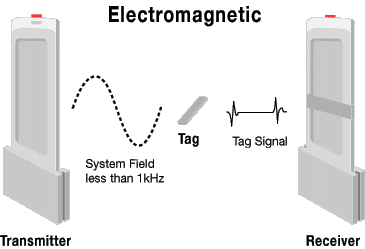How Anti-shoplifting Devices Work (5)

Electromagnetic System
The Electromagnetic (EM) system, which is dominant in Europe, is used by many retail chain stores, supermarkets and libraries around the world. In this technology, a magnetic, iron-containing strip with an adhesive layer is attached to the merchandise. This strip is not removed at checkout — it’s simply deactivated by a scanner that uses a specific highly intense magnetic field. (One of the advantages of the EM strip is that it can be re-activated and used at a low cost.)
What most people refer to as an electromagnetic tag is actually a metal wire or ribbon that has high permeability, making it easy for magnetic signals to flow through it, according to Sensormatic’s EAS Product Co. CTO Hap Patterson. “When we drive the tag, flux is being allowed to flow through the tag until it’s saturated,” he says. “When it’s saturated, from a magnetic perspective, it begins to look like air. Saturation occurs abruptly and is an important part of the design of the tag.”
Look at the figure showing the EM system with its receive coil and transmitter on either side and tag in the middle. When the tag goes from active to saturated, the receiver detects the change in the amount of the signal picked up from the transmitter. “If you look at the receiver signal, you’ll see a bump when saturation occurs,” Patterson says. Saturation occurs twice each cycle-once on the transmitter’s positive cycle and once on its negative cycle. What is happening is the system is checking for the special material used to make the tag. (In scientific terms, the permeability of steel is much lower than the metal used to make the tag. In addition, when steel goes to saturation, it tends to do so slowly, not abruptly. So the EM system uses these differences to differentiate between a still-active tagged item leaving the store and a wrench in someone’s pocket.)
A magnetized piece of semi-hard magnetic material (basically, a weak magnet) is put up next to the active material to deactivate it. When you magnetize the semi-hard material, it saturates the tag and puts it in its inactive saturated state.
That same kind of tag is often used in the library, where it can be reactivated by demagnetizing the semi-hard magnetic material.
The EM system works by applying intensive low frequency magnetic fields generated by the transmitter antenna. When the strip passes through the gate, it will transmit a unique frequency pattern. This pattern is, in turn, being picked up by an adjacent receiver antenna. The small signal is processed and will trigger the alarm when the specific pattern is recognized. Because of the weak response of the strip and the low frequency (typically between 70 Hz and 1 kHz) and intensive field required by the EM system, EM antennas are larger than those used by most other EAS systems, and the maximum distance between entry pedestals is 40 inches. Also, because of the low frequency here, the strips can be directly attached to metal surfaces. That’s why EM systems are popular with hardware, book and record stores.
